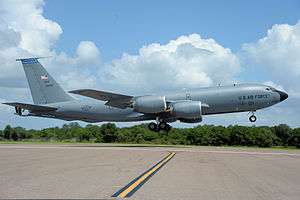6th Air Mobility Wing
| 6th Air Mobility Wing | |
|---|---|
|
6th Air Mobility Wing KC-135R Stratotanker, AF Ser. No. 61-0305, takes off from MacDill Air Force Base, 29 May 2013 | |
| Active | 30 September 1919 |
| Country |
|
| Branch |
|
| Part of |
Air Mobility Command Eighteenth Air Force |
| Garrison/HQ | MacDill AFB, Florida |
| Motto(s) |
"Parati Defendere" Ready to Defend |
| Equipment | KC-135 Stratotanker, Gulfstream C-37A |
| Engagements |
|
| Decorations |
|
| Commanders | |
| Current commander | Colonel Daniel Tulley[1] |
| Insignia | |
| 6th Air Mobility Wing emblem |
 |
The United States Air Force's 6th Air Mobility Wing (6 AMW) is the host wing for MacDill Air Force Base, Florida. It is part of Air Mobility Command's (AMC) Eighteenth Air Force. The wing's 6th Operations Group is a successor organization of the 3d Observation Group, one of the seven original combat air groups formed by the United States Army Air Service shortly after the end of World War I.[2]
The 6th Air Mobility Wing provides day-to-day mission support to more than 3,000 personnel along with more than 50 mission partners, including the United States Central Command and United States Special Operations Command. It is a force capable of rapidly projecting air refueling power anywhere in the world. The 6 AMW is organized into four unique groups and three operational flying squadrons to carry out its mission to be provide air refueling, airlift, and air base support.
Units
The 6th Air Mobility Wing consists of:
- 6th Maintenance Group
- 6th Operations Group
- 6th Operations Support Squadron
- 91st Air Refueling Squadron
- 911th Air Refueling Squadron
- The 911 ARS is a Geographically Separated Unit (GSU) at Seymour Johnson AFB, North Carolina
- 310th Airlift Squadron
- 6th Medical Group
- 6th Mission Support Group
Heraldry
The Wing's emblem, approved for the 6th Composite Group in 1924,[2] reflects its origins with a ship sailing through the Gaillard Cut and an airplane flying overhead.
History
Walker AFB
.png)

The 6th Bombardment Wing (Medium) was activated Walker Air Force Base, New Mexico on 2 January 1951, attached to the Eighth Air Force. The unit consisted of the 24th, 39th and 40th Bombardment Squadrons and was initially equipped with Boeing B-29 Superfortress aircraft. The 307th Air Refueling Squadron was also attached until 1952 and operated KB-29P Superfortress Tankers.
The wing has, through temporary bestowal, the lineage and honors of one of the oldest groups in the Air Force, its subordinate 6th Operations Group which was originally activated as the 3d Observation Group in the Panama Canal Zone on 30 September 1919.[2] One of its assigned squadrons had been activated two years earlier during World War I and had been commanded by (then-Captain Henry H. Arnold. During World War II, the 6th Bombardment Group was assigned to the Twentieth Air Force and earned two Distinguished Unit Citations for action against Tokyo and the Japanese Empire.[2]
One year after activation, the Sixth converted from the B-29 to the Convair B-36 Peacemaker. On 1 April 1955, the 6th Bombardment Wing was transferred from Eighth Air Force to Fifteenth Air Force. At Walker AFB, the wing was bestowed the history and honors of the USAAF's 6th Bombardment Group in 1952. Operations consisted of strategic bombardment training with air refueling as additional mission in 1951–1952, and again from April 1958. The Boeing B-52E Stratofortress replaced the wing's B-36 in September 1957.
In September 1959, the 24th and 30th Bombardment Squadrons joined the newly assigned 4129th Combat Crew Training Squadron to train B-52 and KC-135 crews. Early in 1965, a second KC-135 squadron was transferred to Walker AFB when Schilling Air Force Base, Kansas, began its inactivation process. This made the Sixth a double-sized wing and one of the largest in SAC with its 60 heavy jet aircraft.
As the Soviet missile threat increased, so did the 6th's mission. The 579th Strategic Missile Squadron (SMS) was activated in 1962 as an SM-65 Atlas-F squadron. This addition of ICBMs resulted in the wing's re-designation as the 6th Strategic Aerospace Wing. After its reactivation, the squadron received its first ICBM on 24 January 1962 and became fully operational during the Cuban Missile Crisis of October–November 1962. However, bad luck dogged the missile squadron's footsteps and three of the twelve sites were lost by explosions on 1 June 1963, 13 February 1964, and 9 March 1964.
On 18 November 1964, it was announced that liquid-fueled Atlas-F missiles would be phased out three years early due to the increased reliability of the solid-fueled LGM-30A Minuteman I ICBM. Accordingly, the 579th Strategic Missile Squadron (SMS) inactivated on 25 March 1965. Soon after, the base was apprised by a second announcement on 8 December 1965 that it was scheduled to close as an active installation.
With the announcement of Walker AFB's closure, the 310th Air Refueling Squadron moved to Plattsburgh Air Force Base, New York on 25 January 1967. The 6th Air Refueling Squadron was inactivated at the same time, and its resources were apportioned out to SAC organizations in need of them. The 6th Strategic Aerospace Wing bomb squadrons also inactivated on 25 March 1967 and their resources were apportioned.
While Walker AFB closed, the inactivation of the wing never happened as the 6th transferred to Eielson Air Force Base, Alaska, without equipment and personnel on 25 March 1967 to become the 6th Strategic Wing.
Notable events during the 6th SAW/SW tenure were:
- 1 February 1959 – Captain Perry Amidon, suspecting the aircraft he was a navigator in to be out of control, ejected from a B-58 Hustler at 24,000 feet. The aircraft’s pilot thought otherwise, however, and landed the plane at Eielson AFB a few minutes later. The uninjured Captain Amidon, flew back to base about an hour later in a helicopter.
- 21 April 1964 – A WB-47 Stratojet belonging to Detachment 1 of the 55th Weather Reconnaissance Squadron crashed on takeoff. Three of the five crewmembers died in the accident.
- 30 September 1965 – An Eielson AFB helicopter crew rescued two Baptist ministers after their light plane crashed between Nome and Moses Point. Throughout the 1960s, Eielson AFB helicopter crews averaged several rescues each year.
- 17 November 1967 – The quick response of the 5010th Combat Support Group to the Chena River flood (12–21 August 1967) and the subsequent help provided to Fairbanks and other communities led to the 5010th’s third Air Force Outstanding Unit Award.
Eielson Air Force Base
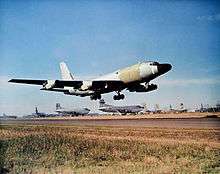
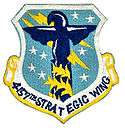
The wing moved to Eielson Air Force Base, Alaska, where it became the 6th Strategic Wing (SW). The wing was assigned the 24th Strategic Reconnaissance Squadron, which carried the same number as one of its previous bombardment squadrons. The 6th had gone full circle and was back in the reconnaissance business as its predecessor had been in 1919, only with RC-135 jet aircraft.
At Eielson, the wing assumed the personnel, equipment and mission of the 4157th Strategic Wing. SAC had formed this unit as the 4157th Combat Support Group on 1 July 1960[3] to provide support for forward deployed SAC bombardment and reconnaissance elements at Eielson. The group was a tenant of the 5010th Air Base Wing (later 5010th Combat Support Group) of Alaskan Air Command.[3] Its original component squadron was the 14th Aviation Depot Squadron' (later the 14th Munitions Maintenance Squadron), which had been at Eielson since 1956 was assigned to oversee the group's special weapons. When the focus of the 4157th shifted to reconnaissance, the 14th was inactivated in 1962.[3] The wing mission expanded to include air refueling support for B-52s involved with Chrome Dome operations[4]
In November 1963, the group was upgraded to wing status as the 4157th Strategic Wing. The 4157th gained an additional unit on 1 July 1965 when the 4157th Consolidated Aircraft Maintenance Squadron was assigned to provide maintenance support for deployed aircraft[3] and was reassigned to the 18th Strategic Aerospace Division,[5] However, SAC Major Command Controlled (MAJCON) Strategic Wings could not carry a permanent history or lineage[6] and SAC took the opportunity presented by the drawdown at Walker to replace the 4157th with the 6th Strategic Wing.[3][7]
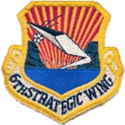
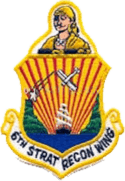
- On 4 October 1968, exactly 11 years to the day after the launch of Sputnik-1, Team-2 Ravens with an RC-135 Rivet Ball aircraft (RC-135S, AF Ser. No. 59-1491) and crew successfully captured the first photographic evidence of a Soviet ICBM test with three Multiple Reentry Vehicles (MRVs).
- On 13 January 1969, a Rivet Ball aircraft (RC-135S, AF Ser. No. 59-1491) hydroplaned off the end of Runway 28 at Shemya Air Force Base while attempting to land after an operational mission. The aircraft was totally destroyed. No one was seriously injured.
- 5 June 1969 – Rivet Amber, an RC-135E assigned to Eielson AFB, crashed in the Bering Sea minutes after leaving Shemya AFB. Nineteen crewmembers died. Amber Hall, the headquarters building at Eielson, was named for the crew a year later.
- On 3 October 1969, the 6th SW held a dining-In at the Eielson, AFB Officer's Club to celebrate its 50th Anniversary (1919–1969).
- 8 July 1971 – When Lieutenant Colonel James O. Swanson became commander of the reincarnated 25th Tactical Air Support Squadron, he had a borrowed desk, a telephone, and a promise for nine aircraft and accompanying personnel. It took two months to get the first O-2A Skymaster and the unit’s complement of 14 officers and eight NCOs would not be complete until June 1972.
- 9 December 1974 – An O-2A, assigned to the 25th Tactical Air Support Squadron at Eielson, crashed while on a routine training mission on the Fort Greely training area near Delta Junction. The pilot and co-pilot were both killed.
- 29 November 1975 – President Gerald R. Ford stopped at Eielson AFB en route to China. Secretary of State Henry Kissinger accompanied Ford, only the second President to visit Interior Alaska and the first to tour Eielson.
- 7 December 1975 – All crewmembers died when a KC-135 assigned to Plattsburgh AFB, New York crashed after takeoff from Eielson.
- February 1977 – Cold weather testing of the A-10 aircraft took place through the end of the month. As part of the test, the aircraft participated in the "Jack Frost" exercise also hosted by the base.
- 12 January 1979 – Five-hundred Eielsonites braved sub-zero temperatures to view the Air Force's newest aircraft, the as yet unnamed F-16, present for cold weather testing.
- On 15 March 1981, an RC-135 Cobra Ball II aircraft (AF Ser. No. 61-2664) departed Eielson for Shemya with 24 people on board. While attempting to land on Shemya they encountered a rapid decline in weather that resulted in a crash landing. Six men lost their lives and several medals were awarded for bravery.
- On 25 February 1985, a Rivet Dandy aircraft (RC-135T, AF Ser. No. 55-3121) used for Cobra Ball training crashed into a mountain top near Valdez, Alaska while on a training mission. All three crewmembers perished. The wreckage was not located until 2 August 1985.
The 6th Strategic Wing also maintained a detachment at Shemya Air Force Base, Alaska, in addition to maintaining the Alaskan Tanker Task Force to support strategic reconnaissance and the North American Air Defense Command's Alaskan ballistic missile early warning station. On 1 April 1988, SAC renamed the wing the 6th Strategic Reconnaissance Wing. During this time it flew the RC–135S and TC-135.
The Wing won the P.T. Cullen Award for greatest contributions to the photo and signal intelligence efforts of Strategic Air Command, 1973, 1978, and 1983.
Announcement of the 6th's most recent inactivation came in December 1991, as the reconnaissance mission of the 6th was transferred to the 55th Wing at Offutt Air Force Base, Nebraska, and the mission of the Alaskan Tanker Task Force was terminated.
The 24th Strategic Reconnaissance Squadron left Eielson AFB on 7 July 1992. The wing lost its operational mission and was inactivated on 1 September 1992. The mission of the 6 SRW, and its assigned aircraft, was transferred to the 55th Wing at Offutt Air Force Base, Nebraska.
MacDill Air Force Base
Following the 1991 Base Realignment and Closure Commission (BRAC) decision to terminate the 56th Fighter Wing's mission at MacDill Air Force Base Florida by the end of 1993 and relocate it and its F-16 Fighting Falcon aircraft to Luke Air Force Base, Arizona, the Air Mobility Command assumed responsibility for MacDill AFB with a mission to operate the base and provide support services for United States Special Operations Command (USSOCOM), United States Central Command (USCENTCOM) and the growing number of other tenant units, as well as to provide services for transient aircraft.
On 22 December 1993, the 6 SRW was redesignated as the 6th Air Base Wing (6 ABW) and activated on 4 January 1994 at MacDill AFB with a primary mission of supporting two unified commands, U.S. Special Operations Command and U.S. Central Command. On 1 October 1996, the wing returned to its flying mission with the relocation of KC-135R Stratotanker aircraft from Malmstrom Air Force Base, Montana and was renamed the 6th Air Refueling Wing (6 ARW). The wing also assumed support responsibility for EC-135Y command post aircraft supporting the USCENTCOM and USSOCOM commanders at MacDill and a CT-43 aircraft supporting the USSOUTHCOM commander in Miami. Both non-tanker aircraft types were later replaced by three VC-37A Gulfstream V aircraft.
On 1 January 2001, with the assignment of the C-37 and extant EC-135Y and CT-43A aircraft and crews to the reestablished 310th Airlift Squadron, the 6 ARW officially gained an airlift mission was redesignated as the 6th Air Mobility Wing (6 AMW), assigned to Air Mobility Command's Eighteenth Air Force.
The 6 AMW has twice won the Air Mobility Rodeo Best Air Mobility Wing Award; in 2000 and 2005.
During 2007 and 2008, the 6 AMW gained an Air Force Reserve Command (AFRC) associate unit when the 927th Air Refueling Wing (927 ARW) relocated to MacDill from Selfridge Air National Guard Base, Michigan minus its KC-135R aircraft pursuant to Base Realignment and Closure Commission action. The 927th's aircraft were transferred to the 127th Wing of the Michigan Air National Guard at Selfridge ANGB. The 927th moved to MacDill AFB on 1 May 2008, with the 6 AMW and 927 ARW sharing the same KC-135R aircraft. All 6 AMW KC-135Rs were marked to include both AMC and AFRC emblems and 6 AMW and 927 ARW markings.
In 2008, the 6 AMW also became the parent wing for the 911th Air Refueling Squadron (911 ARS), a geographically separated unit (GSU) and "Active Associate" squadron flying KC-135Rs of the Air Force Reserve Command's 916th Air Refueling Wing (916 ARW) at Seymour Johnson AFB, North Carolina.
Lineage
- Constituted as the 6th Bombardment Wing on 20 December 1950
- Activated on 2 January 1951
- Redesignated 6th Bombardment Wing, Heavy on 16 June 1952
- Redesignated 6th Strategic Aerospace Wing on 1 May 1962
- Redesignated 6th Strategic Wing on 25 March 1967
- Redesignated 6th Strategic Reconnaissance Wing on 1 April 1988
- Inactivated on 1 September 1992
- Redesignated 6th Air Base Wing on 22 December 1993
- Activated on 4 January 1994
- Redesignated: 6th Air Refueling Wing on 1 October 1996
- Redesignated: 6th Air Mobility Wing on 1 January 2001
Assignments
|
|
Stations
- Walker Air Force Base, New Mexico, 2 January 1951
- Eielson Air Force Base, Alaska, 25 March 1967 – 1 September 1992
- MacDill Air Force Base, Florida, 4 January 1994 – present
Operational Components
Groups
- 6th Bombardment Group: 2 January 1951 – 16 June 1952
- 6th Operations Group: 1 October 1996 – present
Squadrons
- 6th Air Refueling Squadron: 3 January 1958 – 25 January 1967
- 24th Bombardment (later, 24 Strategic Reconnaissance) Squadron: attached 2 January 1951 – 15 June 1952, assigned 16 June 1952 – 25 January 1967; assigned 25 March 1967 – 7 July 1992
- 39th Bombardment Squadron: attached 2 January 1951 – 15 June 1952, assigned 16 June 1952 – 15 September 1963
- 40th Bombardment Squadron: attached 2 January 1951 – 15 June 1952, assigned 16 June 1952 – 25 January 1967
- 307th Air Refueling Squadron: attached c. 1 August 1951 – 16 June 1952
- 310th Air Refueling Squadron: 25 June 1965 – 25 January 1967
- 579th Strategic Missile Squadron: 1 September 1961 – 25 March 1965
- 4129th Combat Crew Training Squadron: 1 August 1959 – 15 September 1963
- 91st Air Refueling Squadron: 1 October 1996 – present
- 310th Airlift Squadron: 1 January 2001 – present
- 911th Air Refueling Squadron: 12 April 2008 – present
Aircraft and missiles
|
|
See also
References
Notes
- ↑ /http://www.macdill.af.mil/library/biographies/bio.asp?id=17977
- 1 2 3 4 Maurer, Maurer, ed. (1982) [1969]. Combat Squadrons of the Air Force, World War II (PDF) (reprint ed.). Washington, DC: Office of Air Force History. pp. 41–42. ISBN 0-405-12194-6. LCCN 70605402. OCLC 72556.
- 1 2 3 4 5 Mueller, Robert (1989). Air Force Bases, Vol. I, Active Air Force Bases Within the United States of America on 17 September 1982 (PDF). Washington, DC: Office of Air Force History. pp. 142–148. ISBN 0-912799-53-6.
- ↑ Abstract, History 4157th Combat Support Group 1962 (retrieved 25 April 2013)
- ↑ "Factsheet 18 Strategic Aerospace Division". Air Force Historical Research Agency. 10 April 2007. Archived from the original on 30 October 2012. Retrieved April 6, 2014.
- ↑ Ravenstein, Charles A. (1984). A Guide to Air Force Lineage and Honors (2d, Revised ed.). Maxwell AFB, AL: USAF Historical Research Center. p. 12.
- ↑ The 6th Strategic Wing continued, through temporary bestowal, the history, and honors of the 6th Bombardment Group. It was also entitled to retain the honors (but not the history or lineage) of the 4157th.
Bibliography
![]() This article incorporates public domain material from the Air Force Historical Research Agency website http://www.afhra.af.mil/.
This article incorporates public domain material from the Air Force Historical Research Agency website http://www.afhra.af.mil/.
- Maurer, Maurer, ed. (1982) [1969]. Combat Squadrons of the Air Force, World War II (PDF) (reprint ed.). Washington, DC: Office of Air Force History. ISBN 0-405-12194-6. LCCN 70605402. OCLC 72556.
- Mueller, Robert (1989). Air Force Bases, Vol. I, Active Air Force Bases Within the United States of America on 17 September 1982 (PDF). Washington, DC: Office of Air Force History. ISBN 0-912799-53-6.
- Ravenstein, Charles A. (1984). A Guide to Air Force Lineage and Honors (2d, Revised ed.). Maxwell AFB, AL: USAF Historical Research Center.
Further Reading
- Ravenstein, C. (1984). Air Force Combat Wings: Lineage and Honors Histories 1947–1977. Office of Air Force History: Washington, D.C. ISBN 0-912799-12-9
- Dorr, R. & Peacock, L. (2000). B-52 Stratofortress: Boeing's Cold War Warrior. Osprey Aviation: Great Britain. ISBN 1-84176-097-8
- Lloyd, A. (1999). A Cold War Legacy: A Tribute to the Strategic Air Command 1946–1992. Pictorial Histories Publishing Co: Missoula, Montana. ISBN 1-57510-052-5
- Air Force Historical Research Agency, 6th Air Mobility Wing
External links
- 6th Mobility Wing at www.globalsecurity.org
- 6th Bombardment Wing at www.strategic-air-command.com
- "A Tale of Two Airplanes" by Kingdon R. "King" Hawes, Lt Col, USAF (Ret.)
